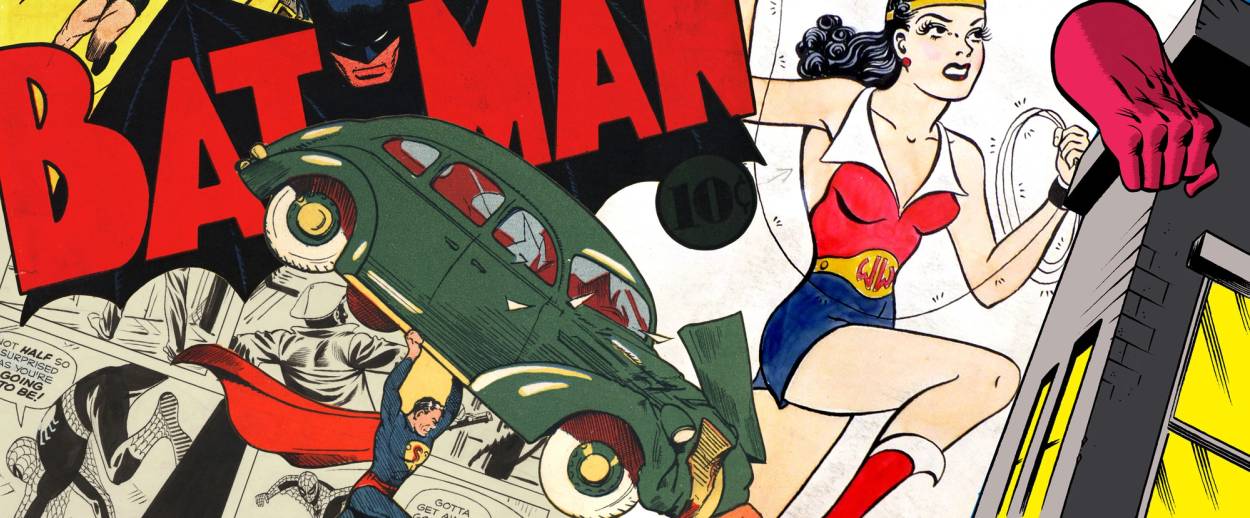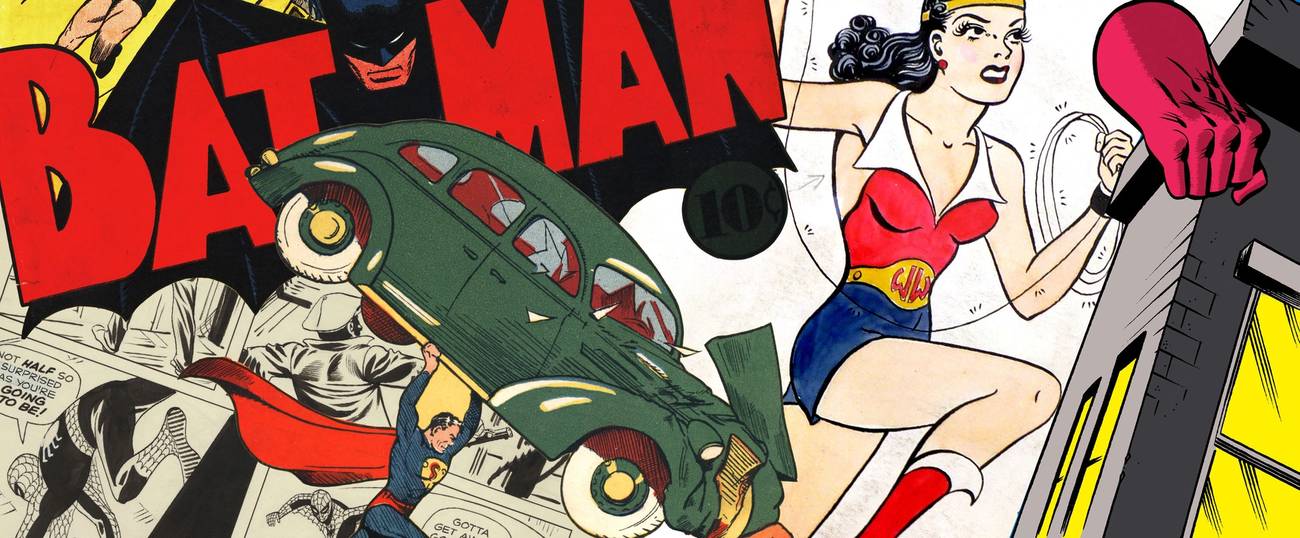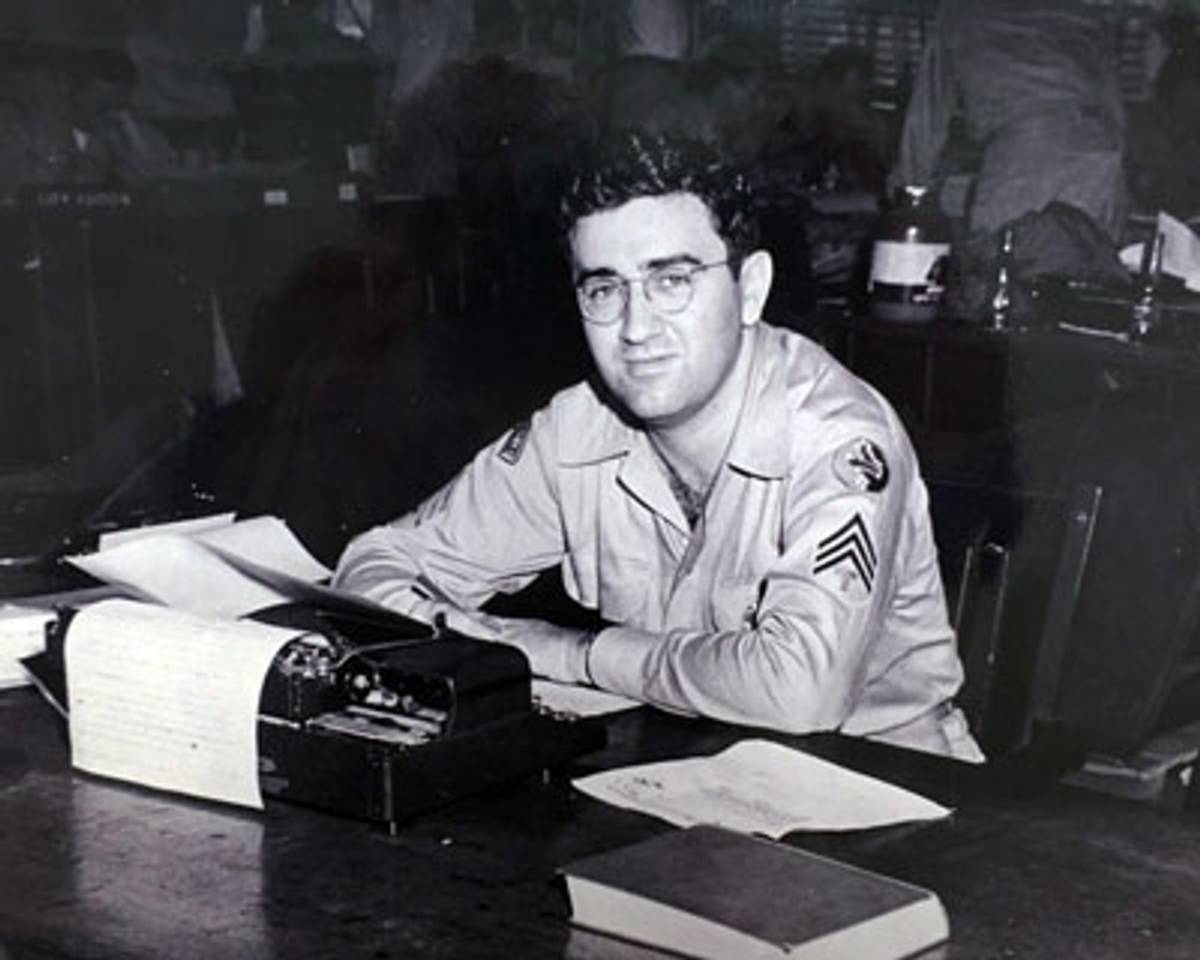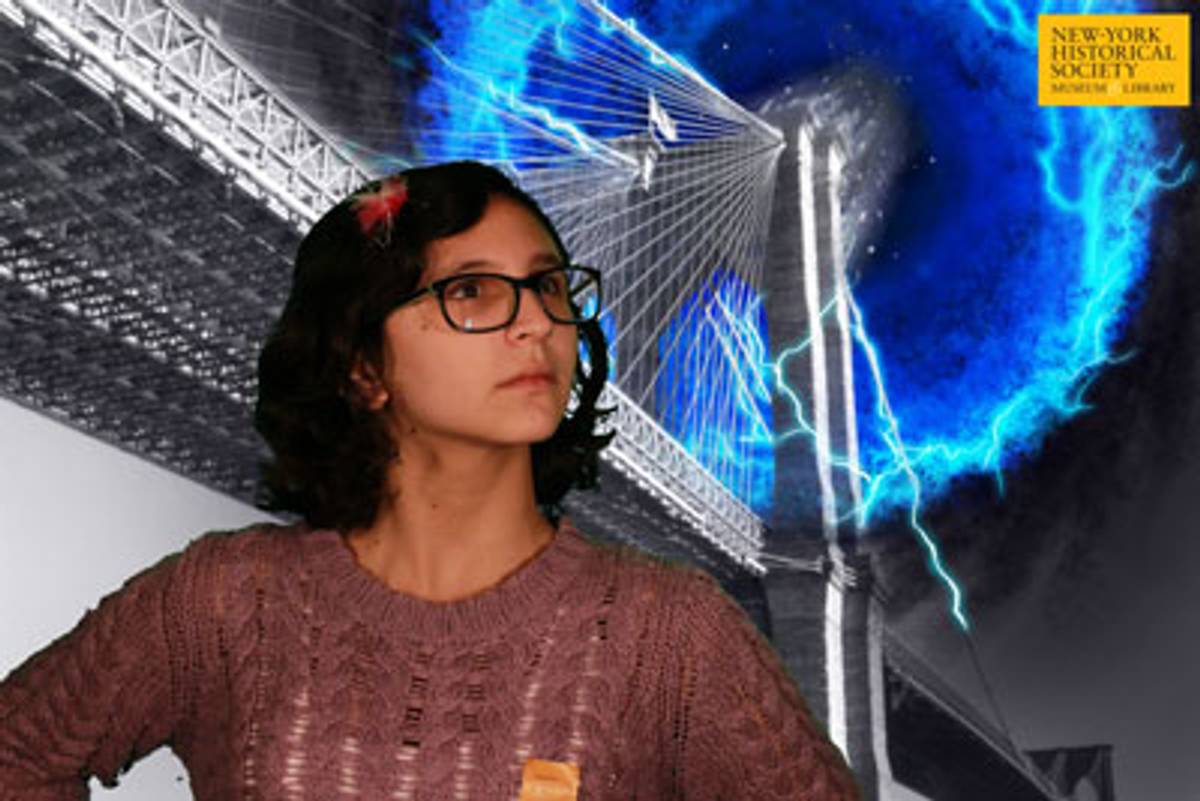Gotham’s Caped Crusaders
A new exhibit at the New-York Historical Society offers Jewish-inflected insight into superhero history—but misses some opportunities to broaden the discussion




I informed my children that they were going to a museum last week on Election Day, when there was no school. Moaning occurred. Also whining. I had to bribe them with the promise of ice cream.
But the museum was the New-York Historical Society, and the exhibit was Superheroes in Gotham, a look at how New York City—in both real and fictionalized form—has influenced generations of comic books and other media.
We entered through the gift shop, and suddenly I was the greatest mom ever, because the New-York Historical Society has an awesome gift shop. Bubbe, who was with us, bought Josie a little black quilted chain purse with a gold Batman logo instead of the interlocked Chanel C’s and with tiny leather bat ears sticking up from the top. Maxie got a pair of red, blue, and gold Wonder Woman socks with tiny, shiny capes billowing from the calves.
And then we entered the lobby, which had the Batmobile in it. An actual Batmobile! Shiny and impressive, custom-built from a 1966 Ford Galaxie, designed by George Barris (who died this week) and driven by Adam West in the TV show. Apparently, to get it into the building, workers had to remove much of the lobby’s glass-paneled front. (Bonus: The lobby also contains a zillion toy trains from the Jerni collection, including an installation kids can actually crawl into and a network of busy tracks swirling over our heads. My train-lover, Maxie, was in heaven.) By this time I figured I could dispense with the ice cream bribe.
The show itself was a qualified hit with my Dynamic Duo. The first room is devoted to the origin stories of Superman, Batman, Wonder Woman, Captain America, Spider-Man, and Ironman. As the wall text notes, most of their creators “were devoted science fiction, pulp magazine, or adventure comic fans from immigrant Jewish families in New York’s working-class neighborhoods. In the 1930s and 1940s, many ‘reputable’ publishing and advertising firms often wouldn’t hire Jewish artists or writers. Comic book publishers, including the predecessors to today’s giants, DC Comics and Marvel Comics, were more welcoming.” These young artists and writers, much like their own creations, adopted secret identities; their own alter egos were more goyish. Robert Kahn, Jacob Kurtzburg, and Stanley Lieber, the show points out, became Bob Kane, Jack Kirby, and Stan Lee.
There’s a fun assortment of objects on display. The kids liked seeing an early Superman suit worn by George Reeves in The Adventures of Superman (1952-1958). Made of cotton and wool, it looks loose and dumpy. The blue is a dull steely color but livelier than its earlier incarnation: In the first few episodes, Reeves wore a gray, tan, and brown version designed for black-and-white film.

Josie, my budding writer, cooed over Superman creator Jerry Siegel’s 1938 Royal typewriter, used to write comics scripts on the train between Cleveland and New York. And this grownup writer got a little thrill from seeing the first issues of Action Comics (1938, featuring Superman’s first appearance) and Batman (1940). If you put Wonder Woman’s lasso of truth around me, I might admit that I fantasized about breaking the glass, racing from the building, and putting the comics on eBay. More seriously, I was delighted to note that the show gave full billing to Bill Finger, the co-creator of Batman, who had credit stolen from him by Bob Kane for generations. In recent months, thanks to the work of comics historians like Marc Tyler Nobleman and others, Finger’s name has been returned to his work. It’s great that the museum was on top of truth, justice, and the American way. (Yes, I know that’s not the Dark Knight’s slogan. Shut up.)
The show also features a video of superhero TV shows and movies from the 1950s to today, run on a loop. Another mom and I got super-excited by clips from the Saturday morning cartoons of our youth. As we squealed and bonded in nostalgic joy, Maxie patted my arm and said gently, “I know you grew up with this, but this is really terrible animation.” Then, as TV Wonder Woman Lynda Carter removed her glasses and started to spin, her hair tumbling from its proper bun, a shocked little boy shrieked, “She’s getting NAKED!”
My fashionistas admired Catwoman’s glittery catsuit (her ears and gold-claw-tipped black gloves are there too, on loan from the Smithsonian), and I got a kick out of seeing the first issue of Ms. magazine, with its iconic Wonder Woman cover. There was a gorgeous old Philco Transitone radio and transcription disks on which Superman’s radio show was recorded and mailed to stations across the country. (By 1940, the wall text informs us, close to 80 percent of American households owned a radio, leading to Superman’s nation-conquering popularity. The show remained on the air until 1951.)
And my kids adored the interactive “NEW YORK NEEDS YOU” superhero transformation booth. Kids pose in front of a green screen and choose different Gotham-y backdrops: a runaway subway train, the Brooklyn Bridge, the New York Hall of Science with its 1964 World’s Fair structures in Queens. They posed for a zillion action shots (the museum was nearly empty, Hallelujah) in which they rescued the city, then emailed them to each other. They also hunkered down for a while in a corner full of graphic novels and children’s book versions of superhero origin stories.
But I had some issues with the show. I love Wonder Woman as much as the next feminist, but why was she in this show? She’s an Amazon who worked for the federal government in D.C.! (Also, a random question: What does it mean that among all these superheroes created by young Jewish men, the only female hero was created by a goy? The family-friendly show delicately steers around the story of Harvard-educated lawyer, psychologist, feminist, and polyamorist William Moulton Marston. To get the scoop, read Jill Lepore’s Secret History of Wonder Woman, and you’ll learn that Marston invented of the first lie detector, based a lot of Wonder Woman on Margaret Sanger, and lived with three women, one of whom wore thick silver bracelets and another of whom was really into bondage. Hello, inspiration for bullet-deflecting magic bracelets and lasso of truth!) Wonder Woman was super cool and kinda kinky, but not a New Yorker.

It also would have been nice if a show purporting to be about superheroes and the city spent more time exploring what the outer boroughs meant to the characters raised there. Spider-Man’s from Queens, and Captain America grew up in Brooklyn. They both begin life as weaklings, and the glittering canyons of Manhattan aren’t part of their world until they come into their powers. Does the privilege of being brought up wealthy in New York City make internal heroism tougher to tap into? Tony Stark’s family mansion near Central Park and all his money didn’t do much to install morality in the dude. There are lots of interesting questions about this hero created at the dawn of the Vietnam War, who becomes a billionaire munitions dealer and anti-hero. The show gets a little lost in Jules Feiffer and Mort Gerberg cartoons (though it’s fun to see the 9-year-old Gerberg’s 1940 Batman drawings in a Hebrew School machberet), in 1970s comics by students at DeWitt Clinton High School (which spawned Kane, Finger, and Lee, as well as Will Eisner), in a wall devoted to Comic-Con, in web comics by Dean Haspiel (displayed on a bolted-down iPad), and in a display about Darryl McDaniels of Run-DMC, who does a comic set in 1985 called Superhero-DMC (in a fedora, thick black glasses, and Adidas shell-tops, naturally). It feels pretty scattershot.
And sadly, the show only dances around big issues of race and privilege in the city. What does it mean to be a black superhero in an era in which black kids have reason to distrust the police and justice system? There are no canonical black superheroes represented: Where, for instance, is Luke Cage? Born as a Blaxploitation-influenced hero in 1972, in a yellow open-to-the-waist disco shirt, Cage inhabited a New York City a lot grittier than that of his predecessors. He gains his superpowers as part of a prison medical experiment and becomes a Hero for Hire, using his abilities for anyone who can pay. He even has an office above a movie theater in Times Square, back before Times Square was Disneyfied. And he’s about to get his own Netflix show. Missed opportunity, superfriends.
Where’s today’s comic-book Spider-Man, the half-black, half-Latino Brooklyn teenager named Miles Morales? Miles is the brainchild of an Orthodox-day-school-educated writer named Brian Michael Bendis. Bendis, who launched this Spidey in 2011, says that Miles’ Brooklyn-ness is essential to who he is and how his stories play out. “The city becomes a character you’re writing about,” Bendis told JTA in an interview. (Why doesn’t this show explore it more?) A former bar mitzvah party caricaturist, Bendis discovered comic books as a teenager. “I studied them like the Torah,” he said. The day after he won an Eisner Award, the Oscars of the comics industry, he was back drawing teen portraits at a bar mitzvah.
And Wonder Woman may be the most popular lady in comicdom, but she’s far from the only one. My daughters adore TV’s Supergirl and Agent Carter, two female crime-fighters battling sexism in the city. (Josie was Agent Carter for Halloween.) And girl superhero comics readers are overjoyed to have Kamala Khan as Ms. Marvel, a Pakistani-American shapeshifting teen from Jersey City who is Marvel’s first Muslim headliner. Jersey City, for her, is what Brooklyn is to Miles: so near the center of the action, yet so far. Comics set in the city today deal with race, religion, class, and gender, but the New-York Historical Society show doesn’t. Not really. Both Khan and Daredevil—an observant Catholic—are city-dwellers whose faith, rituals, and religious expectations in large part drive them, and of course the early superhero creators were defined by their Jewishness.
Of course no museum show can be everything to everyone. Superheroes in Gotham is a fun, super-kid-friendly visit to a simple world in which good triumphs over evil, Captain America punches Hitler in the face, and the world of comics is portrayed as a continuation of the same Bat-time, same Bat-channel.
***
Like this article? Sign up for our Daily Digest to get Tablet Magazine’s new content in your inbox each morning.
Marjorie Ingall is a former columnist for Tablet, the author of Mamaleh Knows Best, and a frequent contributor to the New York Times Book Review.